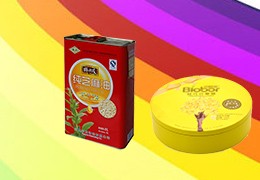Embossed metal tin...
The difference between two cans and three cans

1. Tin can is a can type packaging container made of metal tin plate which has been punched, jointed and welded. It is composed of a can body, a can bottom and a can cover. Three-piece cans, also known as three-piece cans, are so named because the material used is usually made of tinplate. It is often used in canning containers of beverage, dry powder, chemical products and sprays.
Classification of tin
According to the tank type: neck tank, vertical round tank;
According to the structure: open cans, capped cans;
According to the content: beverage can, food can.
According to raw materials: tinplate (tinplate), chrome plate, aluminum alloy.
Production process: take beverage can as an example (color printing iron) shear plate - welding - internal and external filling - baking - neck - flanging - sealing - inspection - full spraying - curing - container - packaging - storage.

Two pieces of tank
The two cans are made up of two pieces, namely the body and the lid, so they are called two cans. A type of canister.
The principle of the body of the two cans is to use the metal tin plate, through the punch molding die, make it by stretching deformation, so that the tank bottom tank body into a body.
There are two kinds of tank bodies: according to the height of the tank body, there are shallow drawing tanks and deep drawing tanks;
According to the canning materials, aluminum cans and tin cans;
According to the manufacturing technology, it can be divided into thinning drawing tank and deep drawing drawing cupping tank.
Advantages and disadvantages of two cans and three cans
Two-piece cans have the following advantages over three-piece cans:
Good sealing. The tank body is formed directly by the punching and drawing process, without leakage, and the leakage detection procedure can be removed.
To ensure the quality of products. Two cans do not need to be welded and sealed, to avoid lead contamination of solder cans, and high temperature sterilization, to ensure product hygiene.
Beautiful and generous. No joints, beautiful shape, and the tank body can be continuous decoration printing, good effect.
High production efficiency. The two cans have only two parts, and the tank body manufacturing process is simple, which is beneficial to simplify the process and improve the production capacity.
Save raw materials. The body of two cans is stretched and deformed during forming, and the wall thickness is thinner than that of three cans. In addition, the body of the two-piece tank is formed as a whole, without longitudinal seam and bottom seam, which also saves material.
However, the two-piece cans have higher requirements on material performance, canning technology, canning equipment, etc., and less types of filling materials.
Application At present, the metal cans used for packaging are mainly aluminum two-piece cans. The aluminum two-piece tank is made of aluminum alloy thin plate, and the thinning drawing process is used in the manufacturing process, so the thickness of the tank wall is obviously thinner than the tank bottom. When used in beer packaging, strong internal pressure will compensate for the rigidity of the thin can walls. However, the high air resistance, light shielding and sealing of metal cans will keep the quality of beer in the cans stable.
2. The structure of the three-piece can is composed of the body, the bottom and the cover. The upper edge and lower edge of the tank body are the tank cover, the joint of the tank body and the tank bottom respectively. In order to seal the tank body edge with a certain specification of the tank cover, the tank body can be designed into a shrinkage cavity structure.
Tank joints are welded (bonded) joints at both ends of the tank body plate after the tank body is formed. There are four joint forms:
Ring bar: when the diameter and height of the tank body are large, the ring bar can be rolled in the circumferential direction to prevent concave and convex of the tank body.
Flanging: the body and lower edge of the tank are properly turned out so as to make a flanging seal with the lid or bottom of the tank.
Expansion ring: the function of the expansion ring is to avoid the permanent deformation caused by the temperature change of the tank body, improve the mechanical strength of the tank cover (bottom), prevent the tank's crimping structure from damage, protect the sealing performance of the sealing structure, and facilitate the identification of spoiled food.
Round edge: The edge hook formed by bending the edge of the tank cover (bottom) inward so as to facilitate the flanging of the tank body as a curling edge seal. The lid differs from the bottom of the can in that it has a deep countersunk head to hold the key in place.
3. Comparison of two-piece cans and three-piece cans
A \ Similarities: Both of them are metal cans with roughly the same material. Most of them are in the form of pop cans, and the top lid is of a structure that is easy to open. The joint treatment of the tank body and the tank cover both adopt double flanging structure.
B \ Different points: The shaping method is different. The two-piece cans are simpler. In terms of structure, the two-piece cans are often shrunk at the neck to make the cans smaller and more beautiful.
C \ compared with three cans, two pieces of tank has the following advantages: (1) the surface can be comprehensive printing and packaging, improve the effect of packaging (2) two cans is qualitative light, thin wall (3) body and tank bottom and no juncture, high mechanical strength, good sealing (4) and volume tank cover sealing work easy (5 molding process is simple, fast molding, in short, two piece cans with three cans has its characteristic each, in practice, usually use the selective according to actual condition.



.jpg)










Latest comments